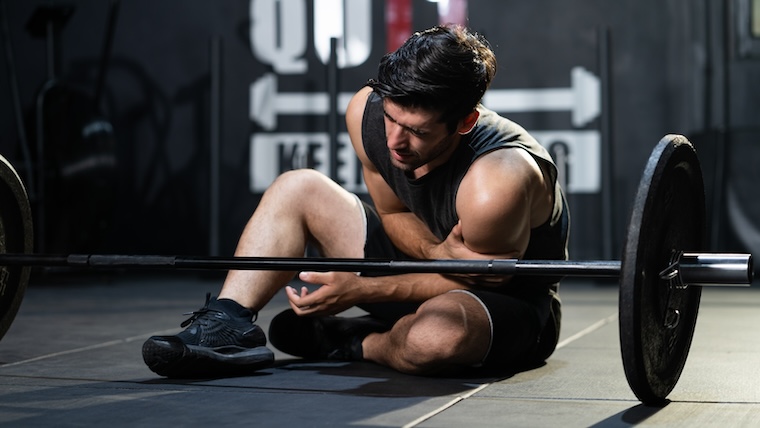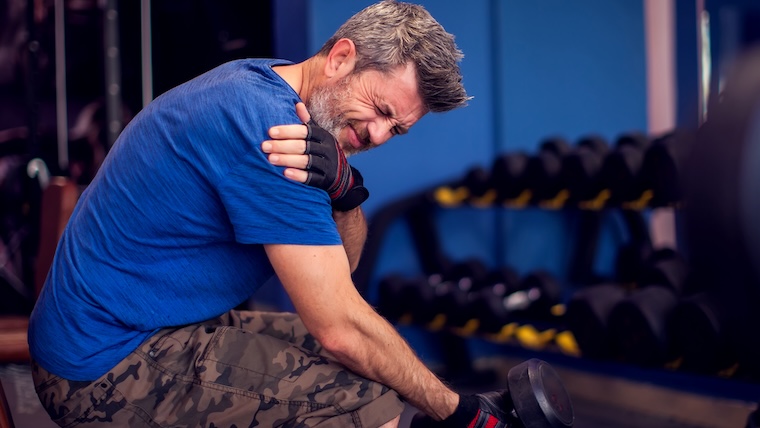Gym injuries are all too common, often stemming from a lack of vigilance or improper lifting techniques. Adhering to proper fundamentals can prevent injuries.
For those new to the gym and those who want to safeguard themselves from common gym injuries, exercise scientist Dr. Mike Israetel recently highlighted the seven most dangerous mistakes people make in the gym.
7 Reasons Injuries Happen at the Gym & How To Mitigate Them
Dr. Israetel offers two important caveats regarding gym injuries:
- It’s impossible to eliminate the risk of injury entirely.
- Some injuries are unavoidable, no matter what precautions are taken.
Despite these circumstances, Dr. Israetel outlines why these seven common injuries happen and how to mitigate the risks:
- Increased susceptibility from previous injury
- Exposure of the body to high forces
- Impact movements
- Unusual positions
- Instability/slipping
- Unusual loads/volume
- Local and systemic fatigue
[Related: What Should You Drink to Stay Legit Hydrated]
Increased Susceptibility From Previous Injury
Injuries often recur in areas with a history of previous damage. While muscles and connective tissues can regain strength, the presence of scar tissue creates a weaker link. Scar tissue’s connection to healthy tissue tends to be fragile. (1)
How To Mitigate
Dr. Israetel suggests starting with a proper, gradual warm-up and increasing loads progressively. Focus on using the correct technique for every rep during your warm-up.
“The warm-up reminds your brain and nervous system of where you’re going to position the bar in space during your working sets,” Israetel said.
Exposure of the Body to High Forces
High forces are the primary factor directly responsible for injuries. “If you had to curl a two-and-a-half pound dumbbell, there is nearly no way you could do it in a way that would hurt you,” Dr. Israetel explained.
How To Mitigate
Avoid frequently training with weights that exceed your five-rep max to minimize injury risk. Prioritize controlled, effective training over excessive loads for muscle growth.
“Heavy doesn’t equal size,” Dr. Israetel advised. “Heavy is defined as anywhere between five and thirty reps, and the higher end of that rep range generally grows muscle, generally about as well as that lower.”
Utilizing fuller, deeper ranges of motion with lighter loads enhances movement quality and reduces the external loads placed on the body, lowering the risk of injury.
Impact Movements
Impact movements, such as jump squats, carry a significantly higher risk of injury than non-impact training. This risk is particularly pronounced in rapid movements, especially those involving sudden shifts from eccentric to concentric motion, which generate sharp spikes in force.

Such movements can strain connective tissues considerably, increasing the likelihood of injury. Understanding these risks will help train more safely and effectively.
How To Mitigate
Athletes engaged in plyometric and power training often focus on changing direction quickly. According to Israetel, while this is a fundamental aspect of their training, it may not directly contribute to muscle growth.
Minimizing impact during movements can optimize muscle development. This involves controlling the eccentric and avoiding overly rapid changes in direction. For example, pausing at the bottom of a rep before accelerating the concentric can be more effective for promoting muscle growth when performing a bench press.
Unusual Positions
Discomfort with technique, particularly under heavy loads or high speeds, can significantly increase injury risk. To reduce this, consider only varying techniques occasionally.
How To Mitigate
Israetel suggests starting new exercises with light loads to ease into them. Prioritizing proper technique and beginning with warm-up sets is essential to ensure safety and success. Injury risk increases when the body is pushed into unfamiliar territory — lifting heavy, moving quickly, or deviating from one’s usual routine.
Even if you stay on track, adopting a new position or movement can still raise the chances of something going wrong. Proceed with caution to avoid setbacks. Focus on familiar, proven techniques with slight variations — nothing too extreme or unconventional.
Instability/Slipping
Instability is detrimental to strength and muscle growth. When the body senses instability, it limits the contraction of the largest muscle groups most responsible for growth. Additionally, instability increases the risk of serious injuries, such as slipping or falling. Tripping is one of the leading causes of gym injuries. (2)
How To Mitigate
Wearing proper shoes to establish a stable footing while lifting. Dr. Israetel advises against wiggling to complete a rep, which can introduce unnecessary instability.
Unusual Loads/Volumes
One common reason for injuries is exposure to unusually high loads and volumes the body isn’t accustomed to handling.
How To Mitigate
It’s best to start with lower volumes when beginning a new training block. Incorporate a deload week with light, easy workouts, introduce new exercises, and gradually build to heavier loads.

This deload period allows for recovery and promotes anabolic resensitization, priming the body for growth. Returning to training with reduced volume and intensity after a break is helpful for preventing injuries without hindering muscle development.
Local and Systemic Fatigue
In extreme fatigue, the body loses the ability to perform fluid and athletic movements. At that point, the physical structure of the muscles, joints, and connective tissues becomes compromised, increasing injury risk.
How To Mitigate
Manage fatigue effectively through proper nutrition, adequate rest, and designing a balanced program that avoids burnout. If fatigue escalates, resist the urge to rely on pre-workout supplements. Prioritize recovery strategies, such as taking a break from the gym, to allow your body to recharge.
References
- Fulton, J., Wright, K., Kelly, M., Zebrosky, B., Zanis, M., Drvol, C., & Butler, R. (2014). Injury risk is altered by previous injury: a systematic review of the literature and presentation of causative neuromuscular factors. International journal of sports physical therapy, 9(5), 583–595.
- Gray, S. E., & Finch, C. F. (2015). The causes of injuries sustained at fitness facilities presenting to Victorian emergency departments – identifying the main culprits. Injury epidemiology, 2(1), 6. https://doi.org/10.1186/s40621-015-0037-4
Featured image via Shutterstock/BritCats Studio